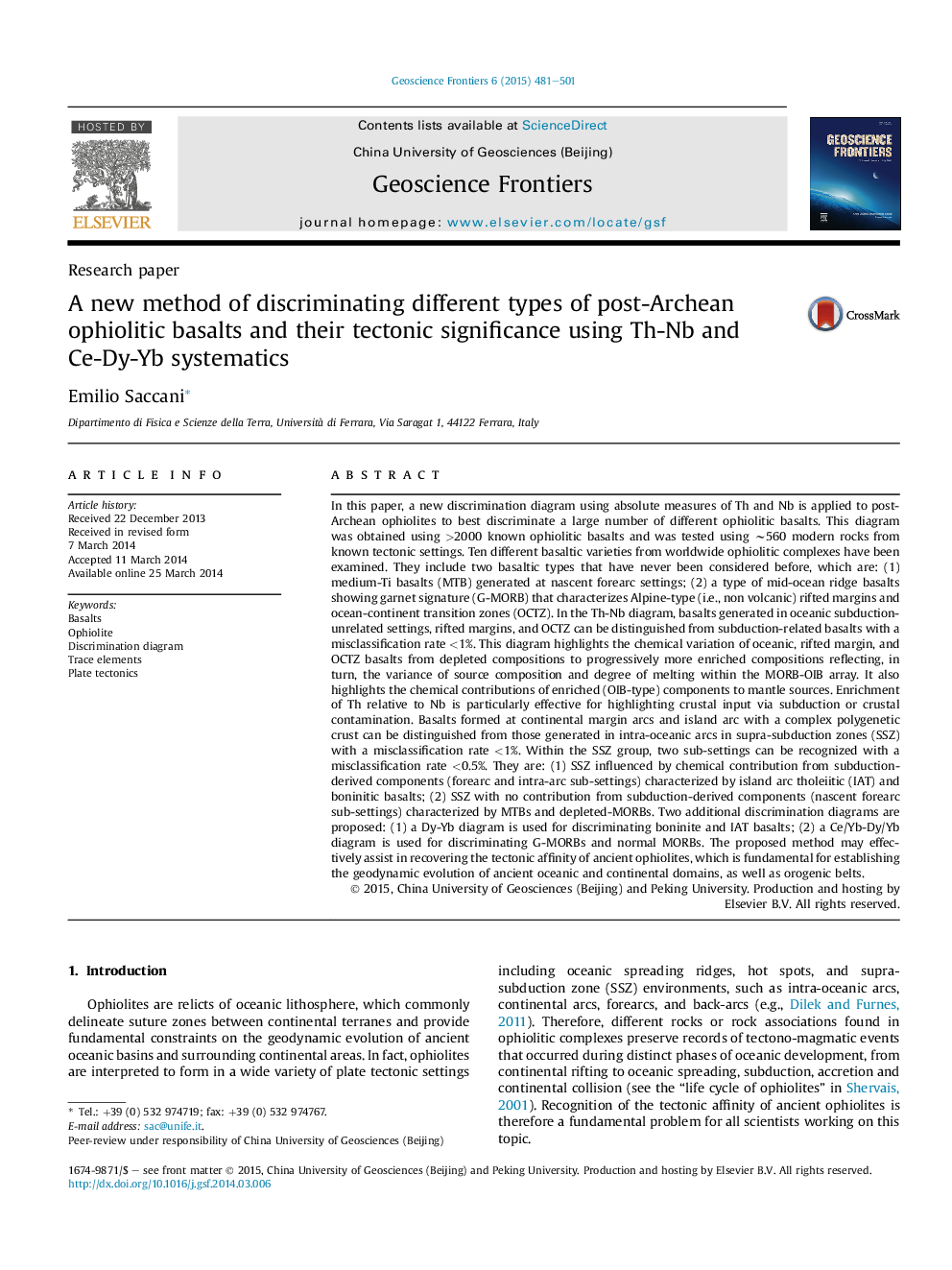| کد مقاله | کد نشریه | سال انتشار | مقاله انگلیسی | نسخه تمام متن |
|---|---|---|---|---|
| 4681601 | 1348861 | 2015 | 21 صفحه PDF | دانلود رایگان |

• A simple Th-Nb diagram is proposed for discriminating different ophiolitic basalts.
• The Th-Nb diagram separates oceanic and arc basalts with a confidence level >99%.
• The Th-Nb diagram effectively (>99%) separates cordilleran- and SZZ-type basalts.
• Th-Nb and Dy-Yb diagrams effectively (>99%) separate different SZZ-type basalts.
• The proposed diagrams assist in the tectonic interpretation of ophiolites.
In this paper, a new discrimination diagram using absolute measures of Th and Nb is applied to post-Archean ophiolites to best discriminate a large number of different ophiolitic basalts. This diagram was obtained using >2000 known ophiolitic basalts and was tested using ∼560 modern rocks from known tectonic settings. Ten different basaltic varieties from worldwide ophiolitic complexes have been examined. They include two basaltic types that have never been considered before, which are: (1) medium-Ti basalts (MTB) generated at nascent forearc settings; (2) a type of mid-ocean ridge basalts showing garnet signature (G-MORB) that characterizes Alpine-type (i.e., non volcanic) rifted margins and ocean-continent transition zones (OCTZ). In the Th-Nb diagram, basalts generated in oceanic subduction-unrelated settings, rifted margins, and OCTZ can be distinguished from subduction-related basalts with a misclassification rate <1%. This diagram highlights the chemical variation of oceanic, rifted margin, and OCTZ basalts from depleted compositions to progressively more enriched compositions reflecting, in turn, the variance of source composition and degree of melting within the MORB-OIB array. It also highlights the chemical contributions of enriched (OIB-type) components to mantle sources. Enrichment of Th relative to Nb is particularly effective for highlighting crustal input via subduction or crustal contamination. Basalts formed at continental margin arcs and island arc with a complex polygenetic crust can be distinguished from those generated in intra-oceanic arcs in supra-subduction zones (SSZ) with a misclassification rate <1%. Within the SSZ group, two sub-settings can be recognized with a misclassification rate <0.5%. They are: (1) SSZ influenced by chemical contribution from subduction-derived components (forearc and intra-arc sub-settings) characterized by island arc tholeiitic (IAT) and boninitic basalts; (2) SSZ with no contribution from subduction-derived components (nascent forearc sub-settings) characterized by MTBs and depleted-MORBs. Two additional discrimination diagrams are proposed: (1) a Dy-Yb diagram is used for discriminating boninite and IAT basalts; (2) a Ce/Yb-Dy/Yb diagram is used for discriminating G-MORBs and normal MORBs. The proposed method may effectively assist in recovering the tectonic affinity of ancient ophiolites, which is fundamental for establishing the geodynamic evolution of ancient oceanic and continental domains, as well as orogenic belts.
Figure optionsDownload as PowerPoint slide
Journal: Geoscience Frontiers - Volume 6, Issue 4, July 2015, Pages 481–501